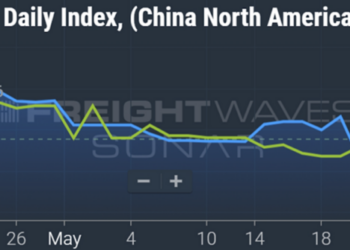Organized labor is having a moment. Unions representing port workers, parcel deliverers, auto workers, writers, actors, teachers and others are securing or seeking to secure hefty salary increases by striking or threatening to strike.
Container shipping flows to the U.S. have been affected by labor negotiations this year — and could be even more affected by union action in 2024.
In June, the International Longshore and Warehouse Union (ILWU), which represents over 40,000 West Coast dockworkers, secured a new contract with a 32% pay raise over six years and a one-time bonus for work during the pandemic.
The next labor battlefield: ports along the East and Gulf coasts.
‘Prepare for the possibility of a coastwide strike’
“Members should prepare for the possibility of a coastwide strike in October 2024,” the International Longshoremen’s Association (ILA) — the union representing 45,000 East and Gulf Coast dockworkers — warned in a press release on Saturday.
The current six-year agreement expires on Sept. 30, 2024. “The union will hold firm on its pledge not to extend the contract beyond its expiration date,” said the ILA.
The timing, coincidentally, will have significant political implications. President Joe Biden has courted the union vote amid recent labor disputes. If the ILA were to go on strike on Oct. 1, port chaos would coincide with the final month of Biden’s reelection bid.
ILA President Harold Daggett will provide an update to members on contract negotiations at a union meeting on Tuesday, building upon his remarks at an ILA convention in July.
“If it goes to the wire, I will guarantee there will be no extensions and we will be out on the street,” said Daggett at the July convention. “Don’t come back and say we cannot afford that kind of raise. You definitely can afford it — and you know it.”
The United States Marine Alliance (USMX) represents dockworker employers at East and Gulf Coast ports and shipping lines serving those facilities. The ILA is seeking a new contract from USMX that includes “a landmark compensation package,” prohibitions against terminal automation and tightened language ensuring all work at new terminals goes to ILA members.
Supreme Court ruling sought on port dispute
The issue of labor positions at new terminals has already boiled over, well before the contract deadline.
The Port of Charleston, South Carolina, opened the Leatherman Terminal in April 2021, the first greenfield U.S. terminal to open since 2009. Leatherman uses a hybrid labor model, with state employees as lift-equipment operators and ILA members in other positions.
The ILA sued USMX and two ocean carriers, Hapag-Lloyd and OOCL, for $300 million (since raised to $500 million), alleging this violated the master contract and that new jobs should go to ILA members. The National Labor Relations Board (NLRB) ruled last December that the ILA had the right to sue. The U.S. 4th Circuit Court of Appeals confirmed the NLRB decision in July.
The case is now up for consideration before the U.S. Supreme Court.
Two and a half years after the 700,000-twenty-foot-equivalent-unit Leatherman Terminal opened for business, “it sits largely idle, and the state’s investment in the port and regional economy is wasting,” said the state of South Carolina in its Supreme Court brief.
Changes to coastal flows, import timing
Meanwhile, five months after the West Coast labor agreement was reached, container shipping flows continue to be affected.
Some importers shifted their supply chains this year in preparation for a possible West Coast strike, switching to services calling at East and Gulf Coast ports. Those changes are “sticky” — while some cargo may have returned to Los Angeles and Long Beach, California, much has not.
The rhetoric alone on a possible strike at East and Gulf Coast ports could affect importers’ supply chain plans next year.
Importers shipping goods from Asia could bring more cargo back to West Coast ports, particularly given growing and concurrent concerns about Panama Canal water levels. Importers could also bring peak-season volume forward to avert the risk of cargoes caught in a strike next October.
If so, that would extend an import timing trend seen this year.
“We’ve seen the calendar evolve and change and inventory pulled forward sooner in the calendar year than was historically the case,” said Matthew Shay, president of the National Retail Federation (NRF), during a Port of Los Angeles press conference on Oct. 23.
“A lot of that is because consumers are shopping differently. We see various retail sales events occurring in the month of July, and we see promotions earlier than ever in the season. So, consumers have changed their behavior and retailers have adapted to that.”
More diverse import sources than West Coast
If dockworkers went on strike at East and Gulf Coast ports next October, the theoretical impact on U.S. import flows could be even more severe than if there had been a West Coast strike.
According to statistics from independent analyst John McCown, the top East and Gulf Coast ports handled 51% of U.S. containerized imports in July-September, the top West Coast ports 49%. The volume is similar.
But the West Coast ports primarily handle imports from Asia, while imports to East and Gulf Coast ports are much more diverse. In addition to Asian cargo arriving via the Panama and Suez canals, these ports handle substantial volumes from Europe and South America.
U.S. Census Bureau data shows that around 20% of all U.S. containerized imports are from Europe, with almost all of those cargoes handled by East and Gulf Coast ports.
In the case of an ILA strike, cargo from China that would have gone to Charleston or Savannah, Georgia, could be rerouted to Los Angeles or Long Beach and shipped overland by rail, a well-established logistics option. Rerouting options would be much more extreme for cargo from Europe that was blocked from unloading on the U.S. side of the Atlantic.
Click for more articles by Greg Miller
Related articles:
East Coast vs. West Coast: More imports shift back to Pacific ports
Shipping braces for impact as Panama Canal slashes capacity
How a fight over 2 jobs bankrupted union of 40,000 dockworkers
ILWU dockworkers union files for Chapter 11 bankruptcy protection
US container imports still rising, topping pre-COVID levels
West Coast port labor deal reached; peak season chaos averted
Confusion reigns as labor dispute ‘fog’ blankets West Coast ports
Labor unrest, canal woes could complicate ‘normal’ peak season
West Coast dockworkers making $200K demand higher pay
West Coast container ports hit as labor talks take ominous turn
The post Crippling port strike could hit 1 month before presidential election appeared first on FreightWaves.














